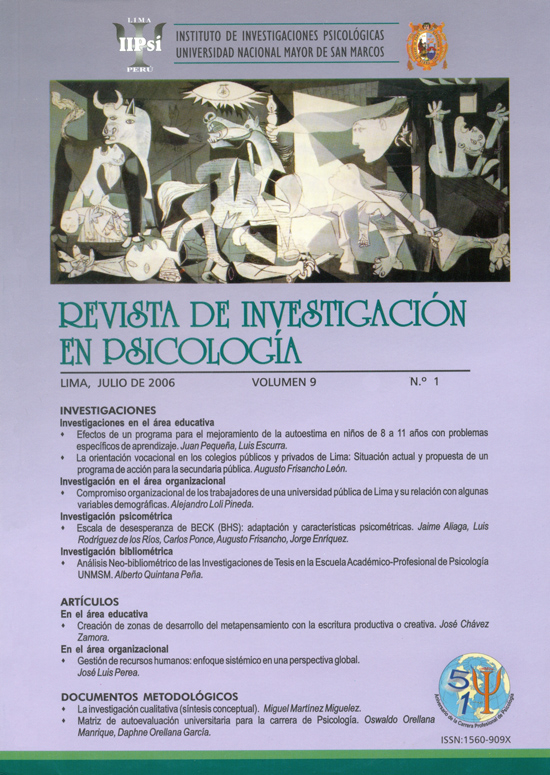Beck Hopelessness Scale (BHS): Adaptation and psychometric characteristics
DOI:
https://doi.org/10.15381/rinvp.v9i1.4029Keywords:
Beck hopelessness scale, adaptation, releability, validityAbstract
In this paper we presented the adaptation and psychometric study of the Beck Hopelesness Scale (BHS). The sample consisted of 782 subjects (372 males and 445 females) The median age was 19 years. The sample this conformated by suicide attempters (n=26); recurrent-episode major depression and bipolar disorder patients (n=23); hipertensives, asmathics and tuberculosius patients (n=68); paranoid schizophrenics and affective disorders patients (n=22); PBC addicts (n= 25); 6th.grade primary students (n= 51); housewives, secondary and universitary students, teachers (n= 567; general population). The Alpha Crombach´s was 0.80 (N= 782) and the Pearson correlation between the test-retest scores for sample (n=100) who were tested at intake and two weeks later was 0.60. The correlation between the BDI Hopelesness/Pessimism item and the BHS was 0.46; the correlation between the BDI subtracting Hopelesness/Pessimism item and the BHS was 0.40. The Factor Analysis of the items whit components principal and varimax rotation techniques found six factors explained the 49.32 of variance. The BHS score was not significantly related to sex but was positively related to age (p<0.01). Finally, the major depression and bipolar disorders patients agrupated in moderate and severe range hopeleness; the general population and the asmathics, hypertensives, tuberculous and PBC addicts patients agrupated in normal and mild range hopelessness. Concluding at the end that the BHS evaluated psychological significative construct and may to be used for screening.Downloads
Published
Issue
Section
License
Copyright (c) 2006 Jaime Aliaga Tovar, Luis Rodríguez de los Ríos, Carlos Ponce Díaz, Augusto Frisancho León, Jorge Enríquez Vereau

This work is licensed under a Creative Commons Attribution-NonCommercial-ShareAlike 4.0 International License.
THE AUTHORS RETAIN THEIR RIGHTS:
a. The authors retain their trademark and patent rights, and also on any process or procedure described in the article.
b. The authors retain the right to share, copy, distribute, execute and publicly communicate the article published in the Journal of Research in Psychology (for example, place it in an institutional repository or publish it in a book), with acknowledgment of its initial publication in the Journal of Research in Psychology.
c. Authors retain the right to make a subsequent publication of their work, to use the article or any part of it (for example: a compilation of their work, lecture notes, thesis, or for a book), provided that they indicate the source. of publication (authors of the work, magazine, volume, number and date).























